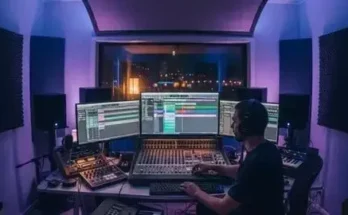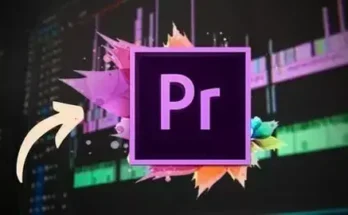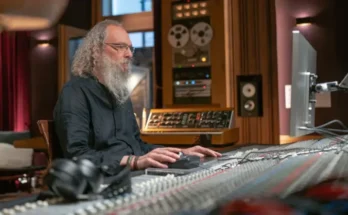Melodic Deep Tech House Production P1
10 May 2020 | 4.73 GB
This tutorial series is an epic journey through the production of a Melodic Deep Tech House/Techno track, covering every aspect of the process along the way, from initial conception to final mixdown (this course is part 1, with arranging and mixing covered in full in parts 2 and 3 respectively). Leaving no stone unturned, the producer Simon Shackleton reveals all of the sound design, audio editing, effects processing, music theory and mixing techniques, so that students receive all the knowledge required to produce professional quality music of their own.
Simon Shackleton has been producing professionally for 25 years, going under aliases such as Lunatic Calm, Zodiac Cartel and Elite Force. His music has received support by DJs across the globe and been featured in films like ‘Charlie’s Angels’ and ‘The Matrix’. Renowned for his meticulous nature, eloquence and ability to produce heavy but musical dancefloor tracks, Simon is the ideal tutor for this course.
In the first part, Simon provides a thorough guide to the creation of every part in the track, from drums, bass and leads, to vocals, pads and FX. An assortment of Loopmasters samples are used for the job, carefully sculpted and layered together, with occasional synths employed for melodic parts. Part 2 then continues the journey, with a detailed look at working the parts into a full-on organic arrangement, which is mixed down in part 3.
THIS COURSE IS PART 1, GOING FROM AN EMPTY PROJECT TO A 64-BAR SEQUENCE, CONTAINING ALL THE SOUNDS IN THE TRACK. PARTS 2 AND 3 COMING LATER THIS SUMMER…
Signing up to the course gives immediate 24/7 access to the streamed tutorials, as well as the Live project from the course, whilst users of all music software can benefit from the 130MB pack of bonus audio samples. Before signing up, check out the free sample module and listen to the track from the course on the Producertech SoundCloud page, for examples of the high standard of tutorial and music quality you can expect from the course. Sign up today to jumpstart your production skills and get on the road to creating Melodic Deep Tech House or Techno anthems of your own!
Module 1 – Compound Kick Drum Creation
A selection of kick samples are layered together, edited and processed to create a compound kick, with appropriate levels of bass, mids and highs, and a powerful, unified sound.
Lesson 1 – Kick Samples 1+2 – 12.07
Lesson 2 – Kick Sample 3 – 8.55
Module 2 – Kick Drum Processing
An effects rack is built using Live factory devices, which is used to process the kick samples, gelling and refining them with EQ, compression and saturation.
Lesson 1 – Building the Rack – 8.13
Lesson 2 – Kick EQ – 10.00
Lesson 3 – Compression, Saturation & Resampling – 10.02
Module 3 – Groove Elements I
An assortment of loops and hits are imported from Loopcloud, which are roughly balanced and edited to form a palette of sounds that embellish the kick and lay the foundations of the groove.
Lesson 1 – Groove Elements Discussion – 6.02
Lesson 2 – Importing Percussion I – 11.34
Lesson 3 – Importing Percussion II – 15.02
Module 4 – Groove Elements II
The different loops are worked through in detail with predominantly EQ treatment to ensure all frequencies are present and correct. There are also various tips for editing and level adjustment, including automation of dynamics to tighten envelopes.
Lesson 1 – Extra Clap – 4.27
Lesson 2 – Processing the Bass Percussion Loop – 7.25
Lesson 3 – Tops EQ – 8.09
Lesson 4 – Tops EQ Part 2 – 9.23
Lesson 5 – Removing Loop Verb & Final Tops EQ – 7.37
Module 5 – Groove Elements III
Some extra percussion elements are brought in, including a pair of tambourine loops, which are cleverly edited and processed to form a unique, composite loop. The percussion are then worked on, with EQ, sample editing and application of spot reverb.
Lesson 1 – Composite Tambourine Loop Creation – 10.13
Lesson 2 – Working with the Main Conga – 6.46
Lesson 3 – Spot Reverb – 11.21
Lesson 4 – Working with the Secondary Conga – 9.02
Module 6 – Sub Bass
A sub bassline is created, to work alongside the bass percussion in forming the bottom end of the track. The instrument used for this is a Live factory synth preset, which is recorded in realtime and then edited.
12.13
Module 7 – Synth Drone
A moody drone part is created from a detuned sample, sequenced into a 2-bar phrase with modulation, then processed with an EQ and compressor.
Lesson 1 – Sequencing the Drone – 10.26
Lesson 2 – Adding EQ & Compression – 6.38
Module 8 – Harmony
After discussing the key of the song, a main chord sequence is laid down, to form the foundations of a more musical portion of the track. Bass parts are then aligned with this new sequence to get everything in tune.
Lesson 1 – Harmony Discussion – 9.24
Lesson 2 – Recording & Editing the Chords – 6.06
Lesson 3 – Repitching Sub Bass – 8.53
Lesson 4 – Repitching Bass Percussion – 10.25
Module 9 – Chord Stabs
By cleverly editing together a combination of different loops, a brand new chord stab sequence is created, which is then processed with effects and consolidated to form a 2-bar loop.
Lesson 1 – Importing & Editing Stabs 1 & 2 – 9.32
Lesson 2 – Adding & Processing Stab 3 – 8.34
Module 10 – Bouncing Lead Synth
Using notes from the main chord sequence as a basis, a new arpeggiated lead sound is created, modulated using various LFO tools to add extra movement and interest.
Lesson 1 – Instrument and Effects Intro – 7.33
Lesson 2 – Recording & Processing the Pattern – 7.52
Module 11 – Getting Creative with Pads
The main chords are taken in a number of directions to create various rhythmic synth parts, with contrasting arpeggiator setups, as well as modulated insert and send FX applications.
Lesson 1 – Resampled Arp Synth – 10.01
Lesson 2 – Arp Automation – 6.31
Lesson 3 – Saturation & LFO-modulated EQ – 12.35
Lesson 4 – Delay Send FX – 6.24
Module 12 – Getting Creative with Leads
Possibilities for the lead synth are explored, with simplified phrases created, whilst the original part is treated with different effects to embellish the arrangement with additional textures.
Lesson 1 – New Sustained Lead – 6.11
Lesson 2 – Tweaking the Bouncing Lead – 4.33
Lesson 3 – Distorted Lead Options – 9.55
Module 13 – Strings
A new strings part is made using a Live factory preset, which is sequenced with the main chords pattern. Various techniques are then employed to add extra movement and width.
Lesson 1 – Adding the Strings – 3.55
Lesson 2 – Creating Width – 8.56
Lesson 3 – Extra Movement – 3.30
Module 14 – Intro Pulses
The gently pulsing synth part from the more complex musical section is stripped down and resequenced to form a new phrase for earlier in the track, to help the transition from one section to another.
Lesson 1 – Intro Pulses 1 – 7.16
Lesson 2 – Intro Pulses 2 – 7.50
Module 15 – Vocal Chops
An assortment of vocal samples are used to create a new phrase for the dubby intro section, as well as underlying textures, to add a human element and some natural ambience to the track.
Lesson 1 – Vocal Ambience and Chop 1 – 9.59
Lesson 2 – Chops 2 & 3 – 8.26
Lesson 3 – Editing & Processing – 11.33
Module 16 – Final Components
Some final components are added to the arrangement, to add sparkle to the mix, embellish with new melodic content and create the necessary builds and drops between sections.
Lesson 1 – Ride Cymbal – 6.33
Lesson 2 – FX Sweeps – 10.39
Lesson 3 – Vinyl Noise – 6.35
Lesson 4 – Synth Chord Texture – 4.24
Nearly 7 hours of streamed lessons
Tips from World Class DJ Producer
Access 24/7/365
Ableton Live Project from the course
130MB of Bonus Samples
Please REPORT in Comment Broken Links




